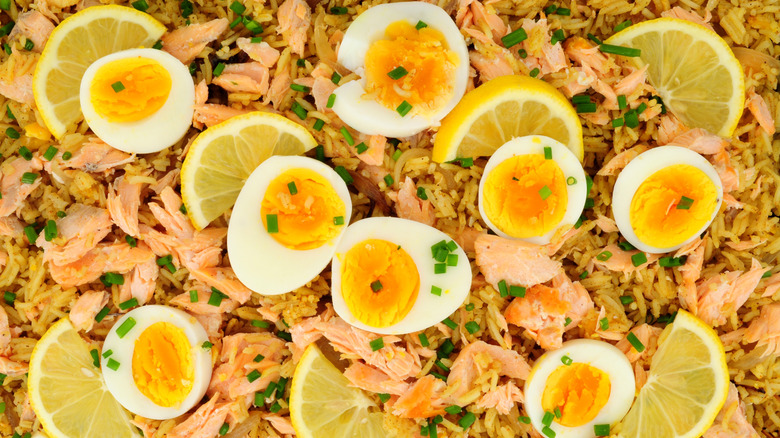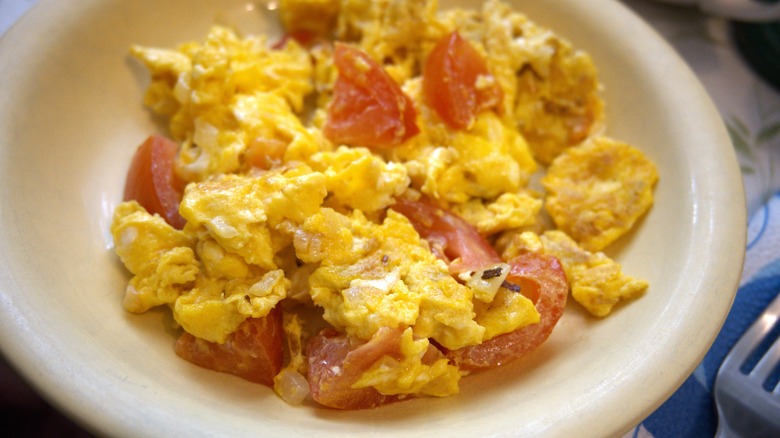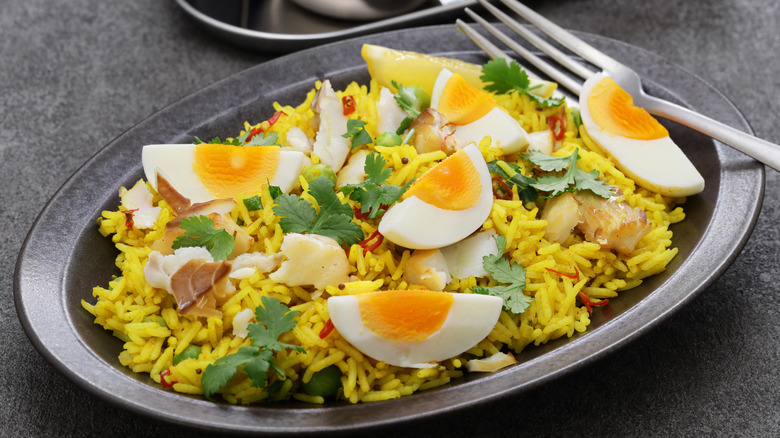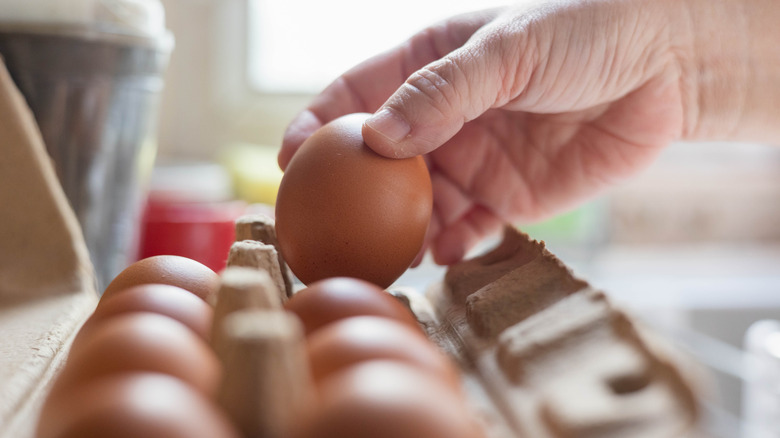Outdated Egg Dishes You Rarely See Anymore
There are a lot of things you can do with an egg. One of the cornerstones of the human diet, eggs have been eaten by humans for thousands upon thousands of years, and most of us eat hundreds of them a year. Plus, we've learned to prepare them in almost every way imaginable: As eggs have been around for so long, by this point, they've been incorporated in countless dishes and used in an extraordinary number of recipes. Inevitably, not all of these recipes have stuck the landing, and a lot of egg dishes throughout history aren't that popular today. To be honest, for some of these, we can kind of see why.
Egg dishes throughout history have often reflected what's popular at the time, with people learning how to incorporate them into recipes in weird and wacky ways, adding a host of other ingredients to their eggs. Eggs have often been used as the primary protein in dishes before better-suited alternatives came along to replace them, or mixed with fad foods that quickly outstayed their welcome. All of this has led to dishes like scalloped eggs, egg timbales, and Campbelled eggs, which you're unlikely to see much these days, but which are definitely worth a revisit.
Eggs à la Goldenrod
There's a common thread with a lot of old-fashioned egg dishes: They have super fancy names for meals that are actually very simple. This is proved by eggs à la goldenrod, which is also known by the less grand name of creamed eggs on toast. Eggs à la goldenrod started gaining popularity in the late 19th century, and it was a go-to for home cooks during the Great Depression, as a breakfast that felt classy but was relatively simple to make. Perhaps its associations with hard times led to it dying out, or perhaps people realized that it was more satisfying (and probably more simple) to whip up a plate of perfect scrambled eggs.
Eggs à la goldenrod was made by making a simple white sauce from butter, flour, and milk, and then mixing in chopped hard-boiled eggs. Cooks would then season it with salt and pepper, and spoon the egg mixture over toast, or serve it in a dish on its own. When times weren't tough, people would also jazz up their eggs à la goldenrod by serving it over salmon, ham, or asparagus. As a finishing touch, you could also grate over some egg yolks, giving it a goldenrod-tinged topping.
Egg timbales
There are plenty of baked egg dishes scattered throughout history, and not all of them have made it to the present day. Egg timbales is one of them, and we can hazard a guess as to why. Egg timbales was a dish that was popular in the late 19th century, and was typically served as an appetizer. It was later featured by Julia Child in "The French Chef," introducing the dish and the concept of a timbale (a baked dish somewhat resembling a flan) to a wider audience.
The issue with egg timbales, though, was what they often called for. The dish was made by greasing a timbale mold and then scattering in chopped-up pieces of organ meat, like tongue or liver, inside. An egg mixture was then poured into the mold, to be baked in the oven in a hot water bath. Once set, it was served on toast, often covered with a white béchamel sauce.
Although we can see the appeal here, we'd imagine that egg timbales dropped off in popularity due to two things: Their filling and their cooking style. Organ meat is now way less appealing than it once was, and baking food in a water bath in the oven can be a rather awkward way of preparing it.
Scalloped eggs
If you're looking to make your breakfast way more fancy (and a lot more effortful), then you'll love scalloped eggs. This old-fashioned fish, which can be found printed in newspapers in the early 1900s, is sort of a cross between scalloped potatoes and a breakfast casserole. To make it, hard-boiled eggs are chopped into wide slices and then layered into a casserole dish. A buttery, cheesy sauce is poured over the top, then it's crowned with breadcrumbs, and a scattering of bacon and fried onions finishes off the whole thing. The dish is then baked until the breadcrumbs are brown and the sauce is bubbling.
Now, we can understand the appeal of this dish: It's hearty, it's filling, and it's cost-effective. The shape of hard-boiled eggs also makes them a natural replacement for potatoes. However, we can't get around the feeling that this is a particularly labor-intensive way of preparing eggs. There's also the risk that the eggs, which are fairly delicate anyway, may fall apart in the oven as they simmer with the creamy sauce.
Eggs à la Caracas
One outdated egg dish we're willing to bet you've never heard of is eggs à la Caracas, a meal which we can only assume is named after the capital city of Venezuela (we're struggling to identify exactly why that's the case based on its recipe, though). Appearing in cookbooks in the late 19th and early 20th century, at first glance, it seems to be a fairly simple version of scrambled eggs, albeit one with smoked beef and tomatoes included. However, things take a left turn when the recipes suggest adding cinnamon into the mix, with others also recommending adding a touch of cayenne.
We get why cayenne would work here, but cinnamon feels a little bit of an odd choice, no? Its spicy, slightly sweet flavor profile isn't generally a natural fit in savory egg dishes, especially those flavored with beef and tomatoes. Nonetheless, people who have made this dish have noted that the cinnamon does add an unexpectedly pleasant flavor. Sadly, though, that doesn't seem enough to keep it around: Eggs à la Caracas is fairly rare nowadays.
Kedgeree
Kedgeree is a lot of things: An old-fashioned egg dish, an early example of fusion cuisine, and a meal that tells a story of colonialism. This dish, which has traditionally been far more popular in the United Kingdom than in the United States, developed from khichdi. A South Asian dish, khichdi is a rice and lentil dish traditionally served at celebratory events, which became popular with English members of the East India Company who were stationed in India in the 17th and 18th centuries.
The dish eventually travelled back to Scotland, with the brother of one Stephana Malcolm introducing her to curried dishes, from which she developed kedgeree. Malcolm added smoked haddock and hard-boiled eggs into the mix with spiced rice, and the dish was born. Kedgeree subsequently became popular during Queen Victoria's reign, and was celebrated as an elegant, exciting meal.
Over time, though, kedgeree began to feel stuffy and like the product of a bygone era. Cut to the modern day, and you'll rarely see people preparing it in the U.K. It also never quite took off in the U.S., despite some more recent efforts to revive the dying classic.
Eggs Suzette
Some egg dishes haven't been able to survive the passing of time, despite receiving royal approval. Eggs Suzette is a prime example of this, as a meal that was famously Princess Diana's favorite dish. The meal was made for her by private chef Darren McGrady, and became more of a regular feature in Diana's life following her divorce from Prince Charles. She would often eat Eggs Suzette for lunch, although it would also easily make a substantial dinner.
We'd imagine that one of the reasons why eggs Suzette is less popular today (and trickier for folks without royal chefs to make) is because of how laborious it actually is. The dish is, essentially, a baked potato topped with poached eggs and a sauce, but preparing it can take a good few hours from start to finish. You also have to be able to master the notoriously tricky hollandaise sauce. That being said, simpler versions exist, which simply cook the egg inside the potato, covering it with cheese and bacon to make more of a loaded potato skin effect. However, even that can take a while.
Eggs à la Martin
We're not sure who Martin was, but his egg dish never quite stuck the landing. It's a shame, as eggs à la Martin is a pretty tasty meal that's also fairly easy to make. This is a rather basic combo of white sauce and eggs, topped with cheese and baked in an oven. Recipes vary on the order of the ingredients, with some saying that you should crack the eggs onto a bed of white sauce, while others advise pouring the sauce over the raw eggs. We'd imagine the flavor would remain the same either way.
Eggs à la Martin appears to have been a fairly popular dish during the first few decades of the 20th century, showing up in "The Settlement Cook Book" in 1903 and "The Cook County Cook Book" in 1912. This was also a meal that you could mix up with a host of different variations by adding ham or spinach to the dish. We don't know exactly why eggs à la Martin isn't still popular. Perhaps it's the making of the white sauce that makes things a little annoying for home chefs, which we get. Regardless, it's rare to find it nowadays.
Campbelled eggs
Many outdated egg dishes are 19th or early 20th-century creations that have simply become unfashionable over time. Others are more recent, slightly stranger recipes which likely felt retro within a couple of years of invention. One example of this is Campbelled eggs, a breakfast dish created by the Campbell's Soup Company as a way to sell its products. The idea was that Campbell's Soup worked as a sort of seasoning and thickener for scrambled eggs, turning the dish into a hybrid meal that was likely incredibly salty.
To make Campbelled eggs, you simply had to grab your favorite Campbell's soup can and pour it into a bowl. Add eggs and beat the two together before pouring the combo into a buttered, heated skillet. You then had to cook them just as you would scrambled eggs or an omelet, gently stirring and then leaving them until they were fully set.
Although we can see how this might have been a cool way to make eggs in the 1960s, we can also see how it was largely a gimmick. We'd also suspect that it made the eggs a little bit more watery than folks would probably like. All of this means it's no great shock that Campbelled eggs have now disappeared.
Bruges egg savory
Bruges egg savory comes from the world of 70s cooking, a time when new-fangled dishes were being thrown at American cooks constantly in an effort to expand the culinary landscape of the United States. Sadly, not all of them stuck around for good. Bruges egg savory comes from, as you can probably guess, Belgium. The dish made it to the U.S. by way of "Good Housekeeping's World Cookery," a tome published in 1972 that included the egg meal in its pages.
Bruges egg savory, also known as oeufs meulemeester, is a baked egg dish. Sliced boiled eggs are placed into a dish, and a combination of cream and mustard is added to it. It's then topped with cheese, dotted with butter, and placed in an oven until browned. The finishing touch was a couple of shelled prawns on top, which gave the dish a touch of brininess and sweetness. Unfortunately, we also think that it probably created a slightly odd flavor clash which, in our opinion, doesn't quite work. No wonder it never really hit it big in the States.
Shirred eggs
Few egg dishes have the history that shirred eggs can boast. The dish, which most people know as a fairly simple but elegant combination of eggs, cream, and cheese baked in a ramekin, first became popular in the 19th century. It was prominently featured in the famous 1896 cookbook "The Boston Cooking-School Cook Book" by Fannie Merritt Farmer, who suggested that the eggs could be baked inside small tomatoes. They were later brought to a wider audience by Julia Child in her popular cooking shows in the 1960s.
Most notably of all, though, shirred eggs were part of the menu for the Titanic's doomed maiden voyage, as an option for breakfast for its first-class passengers. Perhaps this gave them slightly heavy connotations, or perhaps people simply moved on from the slightly fussy feeling that shirred eggs sometimes have, despite actually being quite easy to make. Nonetheless, these days shirred eggs feel as though they're a dish from the past, and while you might see them served in bistros or fancy hotels here and there, it's pretty rare.










